
上泽充通大¥ Shanghai Jiao Tong University 1896 1920 1987 2006 Lecture 13-1 Metabolic Diversity:Phototrophy 微生物代谢的多样性:光合生物 Chapter 13 in BROCK BIOLOGY OF MICROORGANISMS Chen Feng School of Life Science and Biotechnology Shanghai Jiao Tong University
1896 1920 1987 2006 Lecture 13-1 Metabolic Diversity: Phototrophy 微生物代谢的多样性:光合生物 Chen Feng School of Life Science and Biotechnology Shanghai Jiao Tong University Chapter 13 in BROCK BIOLOGY OF MICROORGANISMS
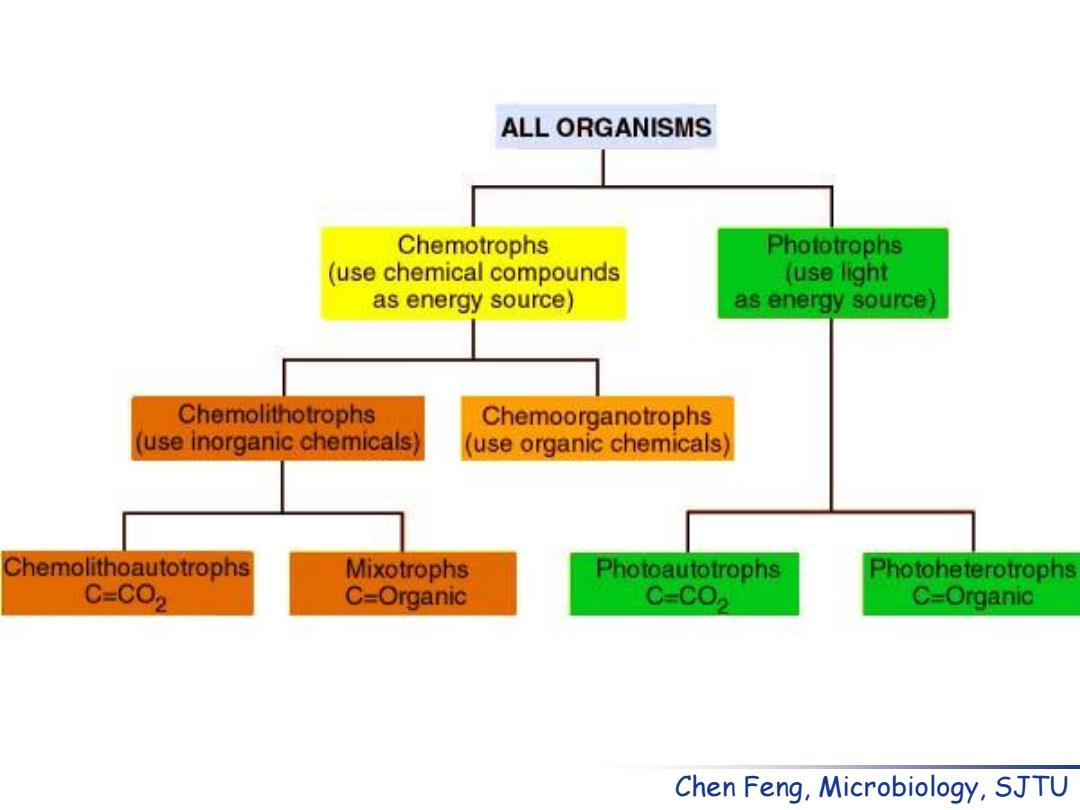
ALL ORGANISMS Chemotrophs Phototrophs (use chemical compounds (use light as energy source) as energy source Chemolithotrophs Chemoorganotrophs use inorganic chemicals (use organic chemicals) Chemolithoautotrophs Mixotrophs Photoautotrophs Photoheterotrophs C=C02 C=Organic C-C02 C=Organic Chen Feng,Microbiology,SJTU
Chen Feng, Microbiology, SJTU
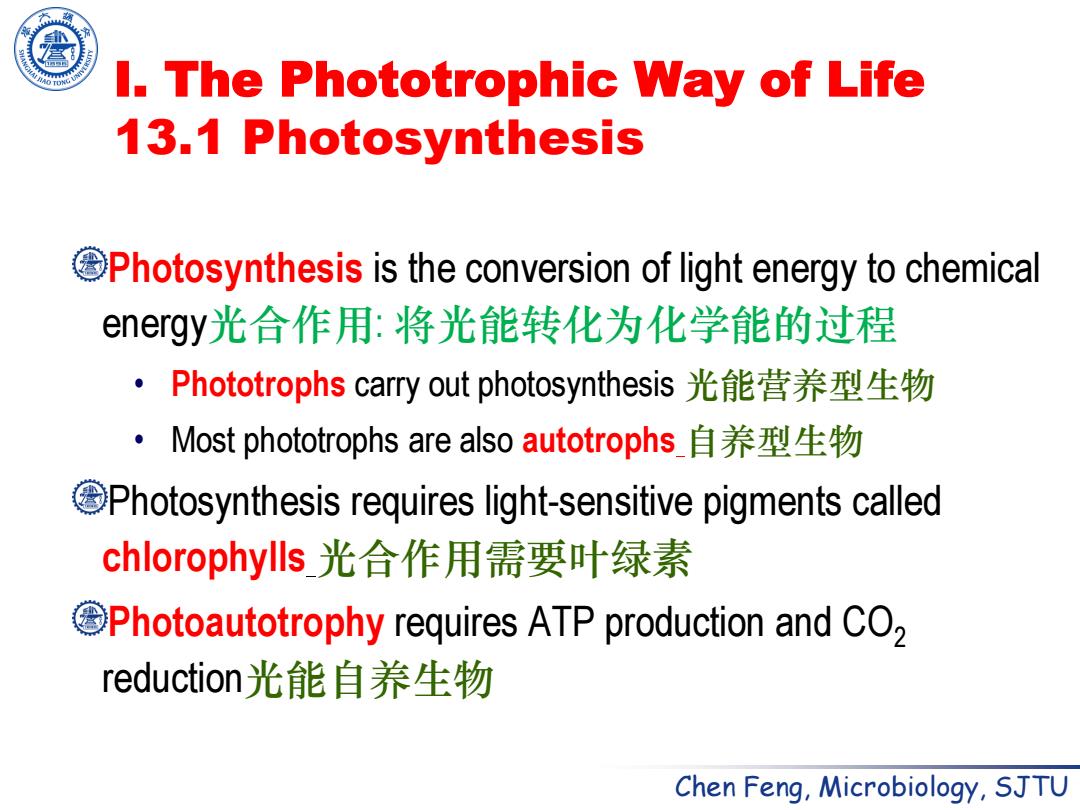
I.The Phototrophic Way of Life 13.1 Photosynthesis Photosynthesis is the conversion of light energy to chemical energy光合作用:将光能转化为化学能的过程 ·Phototrophs carry out photosynthesis光能营养型生物 ·Most phototrophs are also autotrophs自养型生物 Photosynthesis requires light-sensitive pigments called chlorophylls_光合作用需要叶绿素 Photoautotrophy requires ATP production and CO2 reduction光能自养生物 Chen Feng,Microbiology,SJTU
Chen Feng, Microbiology, SJTU I. The Phototrophic Way of Life 13.1 Photosynthesis Photosynthesis is the conversion of light energy to chemical energy光合作用: 将光能转化为化学能的过程 • Phototrophs carry out photosynthesis 光能营养型生物 • Most phototrophs are also autotrophs 自养型生物 Photosynthesis requires light-sensitive pigments called chlorophylls 光合作用需要叶绿素 Photoautotrophy requires ATP production and CO2 reduction光能自养生物
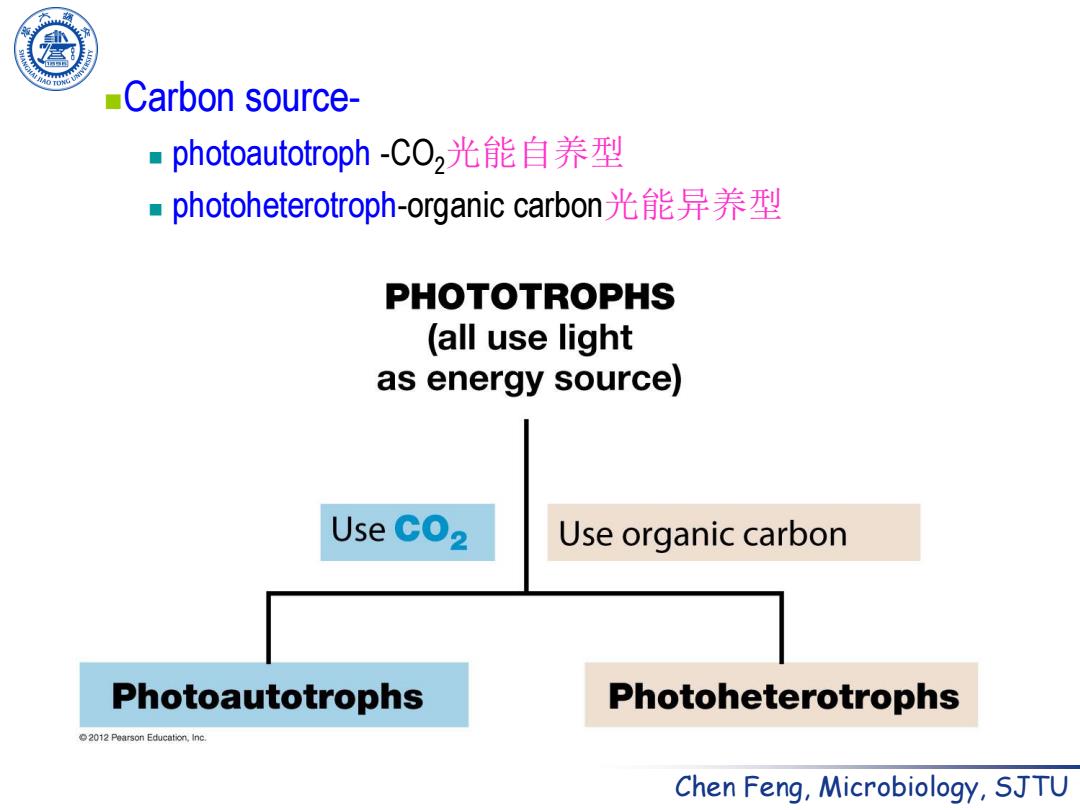
Carbon source- photoautotroph-CO2光能自养型 a photoheterotroph-.organic carbon光能异养型 PHOTOTROPHS (all use light as energy source) Use CO2 Use organic carbon Photoautotrophs Photoheterotrophs 2012 Pearson Education.Inc. Chen Feng,Microbiology,SJTU
Chen Feng, Microbiology, SJTU Carbon source- photoautotroph -CO2光能自养型 photoheterotroph-organic carbon光能异养型

Reducing power还原力 Green plants,algae,and cyanobacteria use H2O as a source of reducing power to reduce NADP+to NADPH and produce O2 as a by-product.绿色植物,藻类,蓝细 菌以水为电子供体,产生02为副产物 Some phototrophic bacteria obtain reducing power from other electron donors,typically reduced sulfur sources (H2S,S,S2032)orH2.某些光合细菌以还原性硫化 物或氢为电子供体 Photosynthesis Chen Feng,Microbiology,SJTU
Chen Feng, Microbiology, SJTU Reducing power 还原力 Green plants, algae, and cyanobacteria use H2O as a source of reducing power to reduce NADP+ to NADPH and produce O2 as a by-product.绿色植物,藻类,蓝细 菌以水为电子供体,产生O2为副产物. Some phototrophic bacteria obtain reducing power from other electron donors, typically reduced sulfur sources (H2S, S0 , S2O3 2- ) or H2 .某些光合细菌以还原性硫化 物或氢为电子供体 Photosynthesis
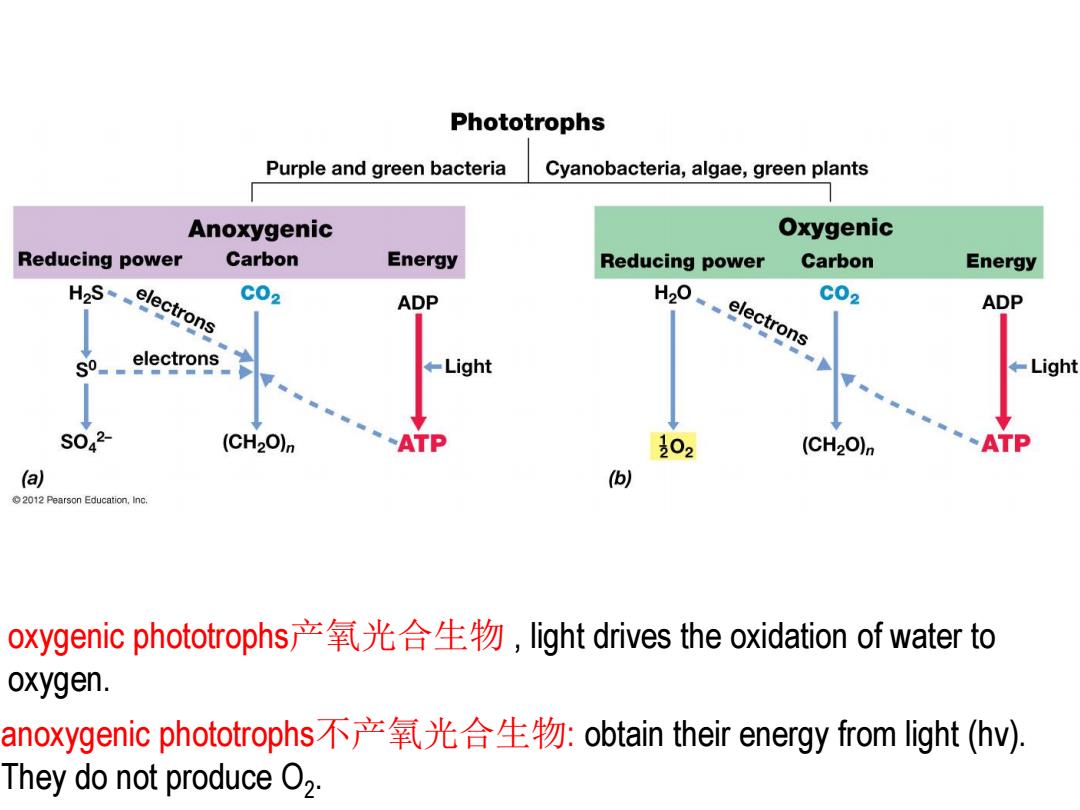
Phototrophs Purple and green bacteria Cyanobacteria,algae,green plants Anoxygenic Oxygenic Reducing power Carbon Energy Reducing power Carbon Energy H2S~-electrons C02 ADP H20、 C02 electrons ADP electrons Light ←Light S042 (CH2O)n ATP 302 (CH2O)n ATP a ) 2012 Pearson Education,Inc. oxygenic phototrophs产氧光合生物,light drives the oxidation of water to oxygen. anoxygenic phototrophs不产氧光合生物:obtain their energy from light(hv) They do not produce O2
oxygenic phototrophs产氧光合生物 , light drives the oxidation of water to oxygen. anoxygenic phototrophs不产氧光合生物: obtain their energy from light (hv). They do not produce O2
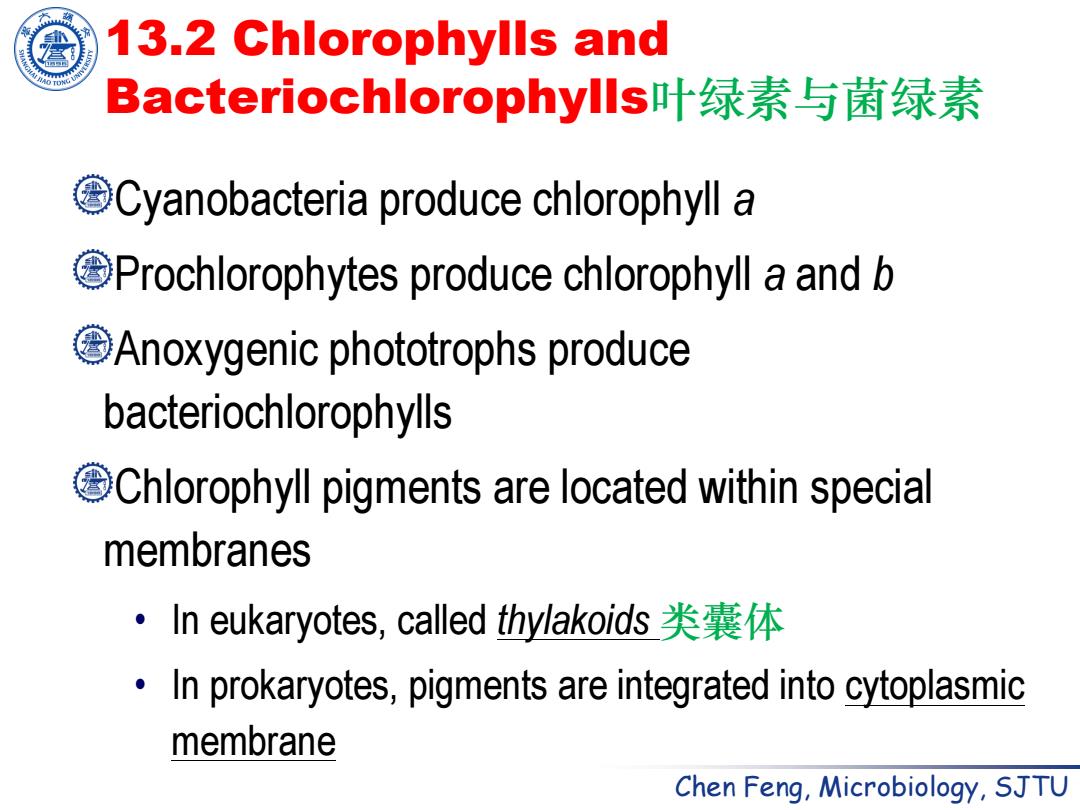
13.2 Chlorophylls and Bacteriochlorophylls叶绿素与菌绿素 Cyanobacteria produce chlorophyll a Prochlorophytes produce chlorophyll a and b Anoxygenic phototrophs produce bacteriochlorophylls Chlorophyll pigments are located within special membranes ·In eukaryotes,called thylakoids类囊体 In prokaryotes,pigments are integrated into cytoplasmic membrane Chen Feng,Microbiology,SJTU
Chen Feng, Microbiology, SJTU 13.2 Chlorophylls and Bacteriochlorophylls叶绿素与菌绿素 Cyanobacteria produce chlorophyll a Prochlorophytes produce chlorophyll a and b Anoxygenic phototrophs produce bacteriochlorophylls Chlorophyll pigments are located within special membranes • In eukaryotes, called thylakoids 类囊体 • In prokaryotes, pigments are integrated into cytoplasmic membrane
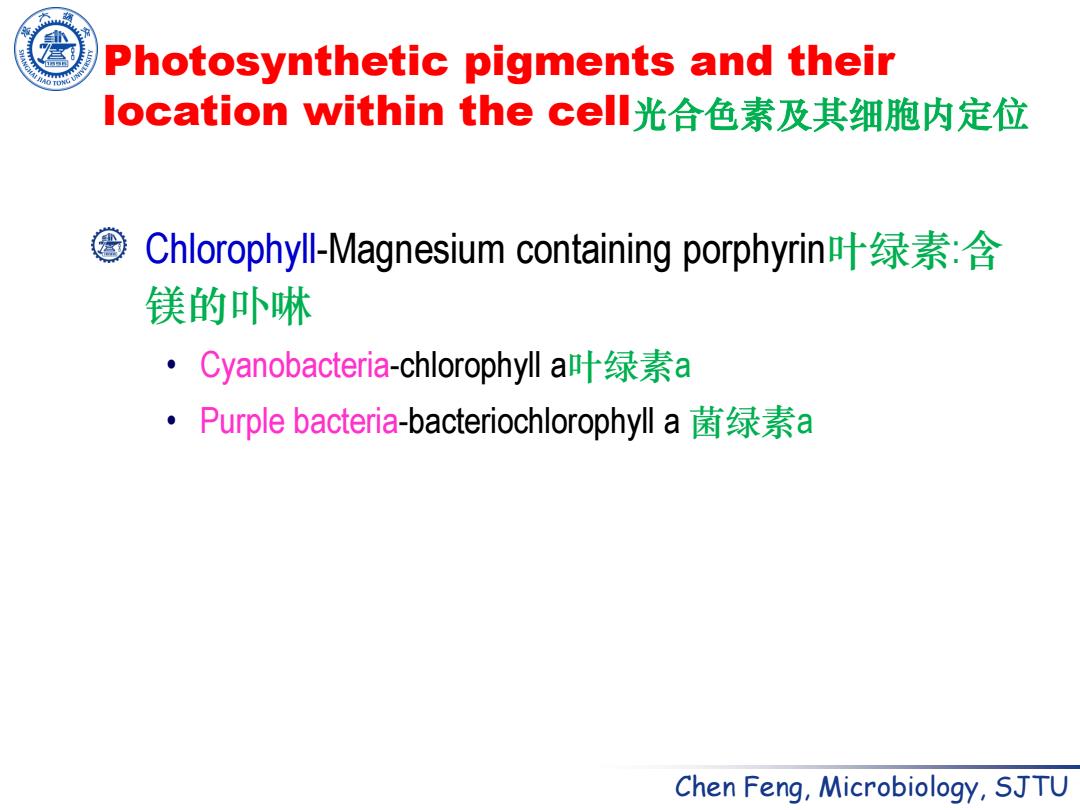
Photosynthetic pigments and their location within the cell光合色素及其细胞内定位 Chlorophyl-Magnesium containing porphyrin叶绿素:含 镁的卟啉 ·Cyanobacteria-chlorophyll a叶绿素a ·Purple bacteria-bacteriochlorophyll a菌绿素a Chen Feng,Microbiology,SJTU
Chen Feng, Microbiology, SJTU Photosynthetic pigments and their location within the cell光合色素及其细胞内定位 Chlorophyll-Magnesium containing porphyrin叶绿素:含 镁的卟啉 • Cyanobacteria-chlorophyll a叶绿素a • Purple bacteria-bacteriochlorophyll a 菌绿素a
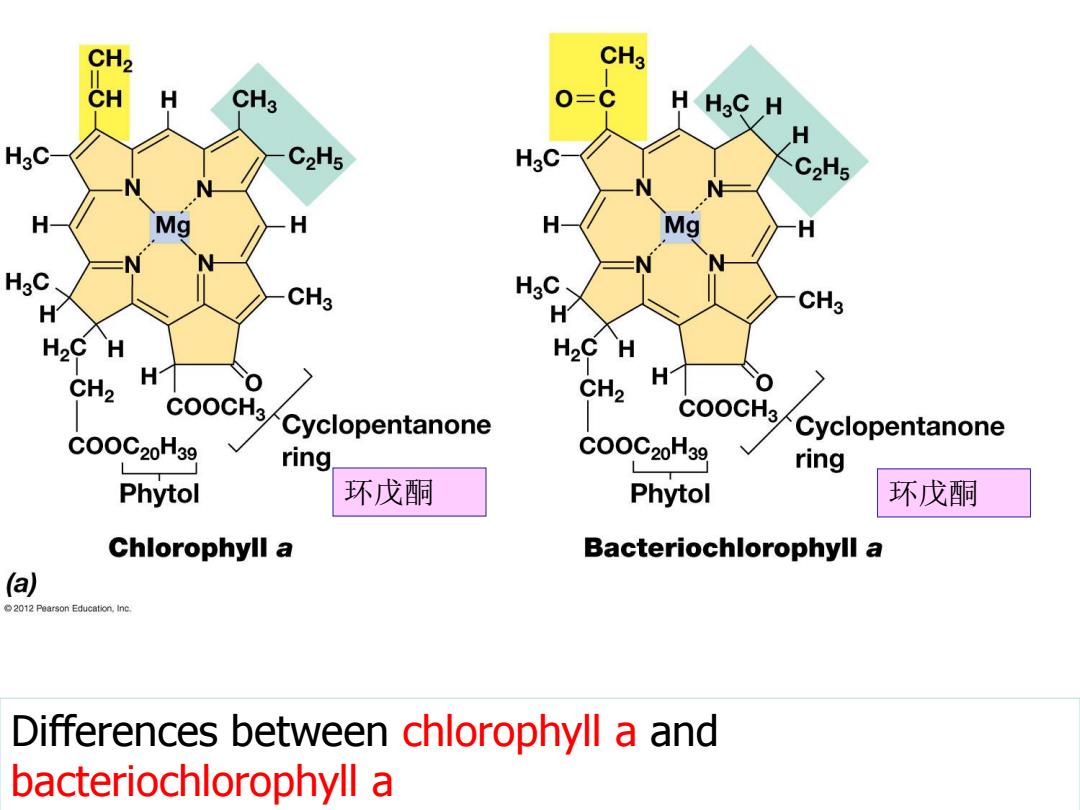
CH2 CH3 CH H CH3 O=C H HgC H H HgC C2H5 HgC C2H5 H H H Mg H HgC H CH3 Hg H CH3 H2C H H2C CH2 H COoCHs CH2 H1 0 Cyclopentanone COOCH3 COOC20H39 COOC20H39 Cyclopentanone ring ring Phytol 环戊酮 Phytol 环戊酮 Chlorophyll a Bacteriochlorophyll a a 2012 Pearson Education.Ine. Differences between chlorophyll a and bacteriochlorophyll a
环戊酮 环戊酮 Differences between chlorophyll a and bacteriochlorophyll a
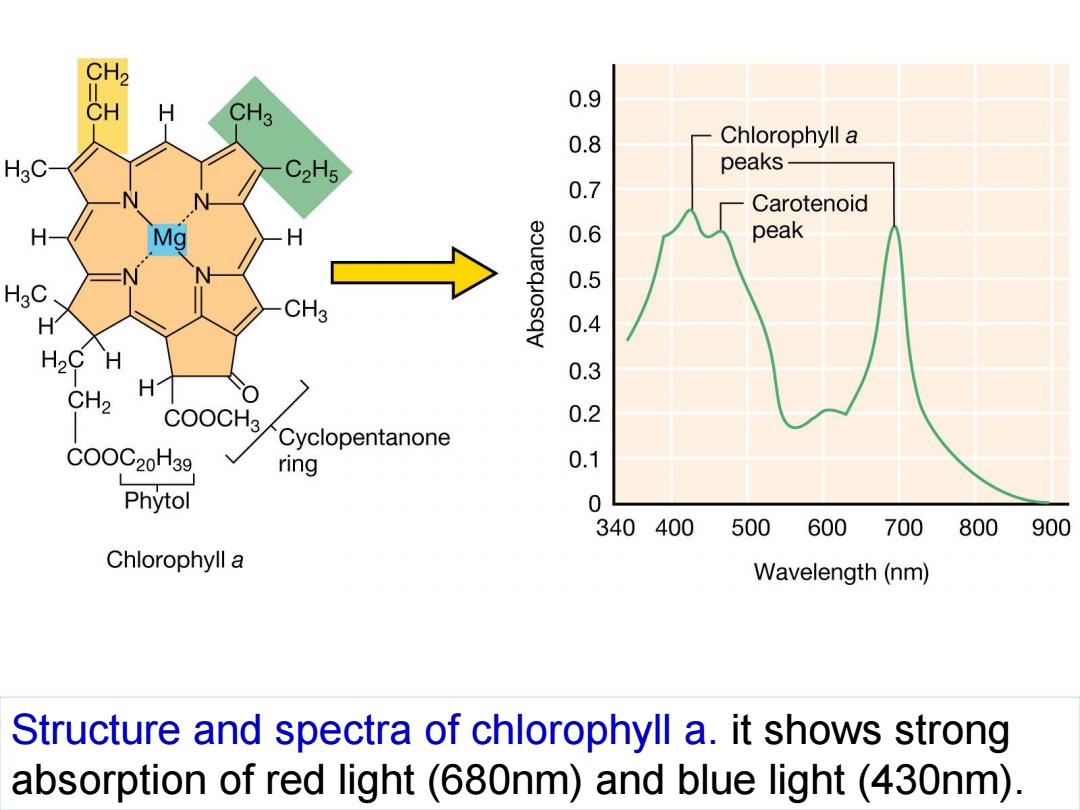
CH2 CH H CH3 0.9 0.8 Chlorophyll a HgC C2H5 peaks 0.7 Carotenoid H 0 peak 0 CH3 0. H2C H 0 CH2 H COOCH3 0.2 Cyclopentanone COOC20H39 ring 0.1 Phytol 0 340400 500 600 700 800 900 Chlorophyll a Wavelength(nm) Structure and spectra of chlorophyll a.it shows strong absorption of red light(680nm)and blue light(430nm)
Structure and spectra of chlorophyll a. it shows strong absorption of red light (680nm) and blue light (430nm)